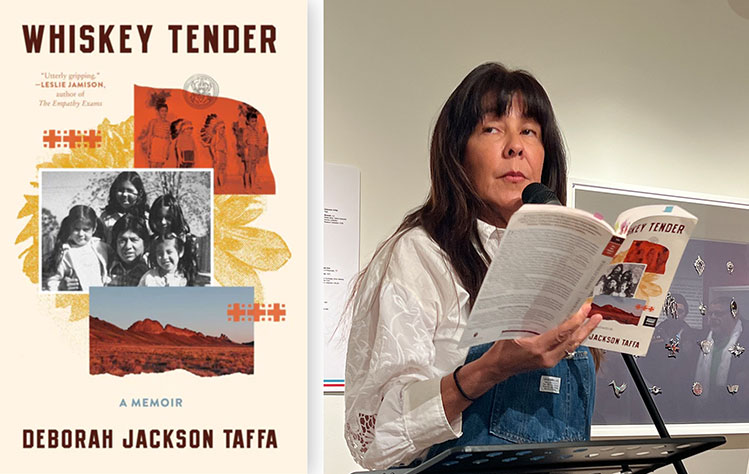Alumna Deborah Jackson Taffa Earns a Prestigious NEA Grant
February 23, 2024
 Webster University alumna Deborah Jackson Taffa ’10 was surprised, humbled, and overjoyed
when she received the call from the National Endowment for the Arts (NEA) alerting
her that she had earned a coveted NEA Fellowship, a prestigious grant that helps fund
travel, research and other costs for new writers as they work on a book.
Webster University alumna Deborah Jackson Taffa ’10 was surprised, humbled, and overjoyed
when she received the call from the National Endowment for the Arts (NEA) alerting
her that she had earned a coveted NEA Fellowship, a prestigious grant that helps fund
travel, research and other costs for new writers as they work on a book.
She almost didn’t take the call from the NEA. Taffa typically avoids calls from unknown numbers, but that day at her doctor’s office she serendipitously decided to answer her phone. “It was very emotional and validating to hear the news.”
Taffa has already earned much respect among critics. Besides the NEA Fellowship, she received an Indigenous Visionary Women’s Leadership Award from the AICF (2023-2024), a Kranzberg Arts Fellowship (2022-2023), PEN America Jean Stein Grant (2022), a Tin House Fellowship (2022), and a Rona Jaffe/Hedgebrook Fellowship (2022). These awards came from her many essays, which can be found in the Los Angeles Review of Books, A Public Space, The Best of Brevity, Salon, The Huff Post, and The Best American Nonrequired Reading. She will use the NEA grant to work on her second memoir.
Her first memoir, “Whiskey Tender,” will be published by HarperCollins Feb. 27. Already, it has been featured on several “most anticipated lists,” notably by The New York Times and ELLE Magazine. The latter describes “Whiskey Tender” as a “…memoir of assimilation and separation as a mixed-tribe Native woman raised in the shadow of a specific portrait of the American Dream…”
In the book, Taffa illustrates her childhood in New Mexico while threading through the histories of her parents and grandparents, themselves forever altered by Indian boarding schools, government relocation, prison systems, and the “erasure of [our] own people.”
Taffa characterizes her birthplace as “made historically relevant by a geographic bend known as the “Yuma Crossing.” Due to this deep bend that slows the Colorado River, the Yuma Crossing was the only way forward for California-bound miners during the Gold Rush in the mid-nineteenth century. Taffa’s roots also extend to the broader region; her paternal grandfather’s people, the Kwatsaán (Yuma) Nation, had ancestral homeland on the river’s west bank in California, her paternal grandmother was from Laguna Pueblo in New Mexico, and her mother was born in Socorro, New Mexico. Taffa herself was born across the Colorado River in Arizona as the Yuma reservation’s hospital was not prepared to deliver babies.
Taffa’s father was trained by the federal government’s Indian Relocation Act of 1956 — also known as Public Law 959 or the Adult Vocational Training Program — which was created to encourage Native Americans to leave reservations to gain vocational skills and integrate themselves into the general population. Her father later accepted a job in the Four Corners region at the intersection of Utah, Colorado, Arizona and New Mexico, moving the family to Farmington, New Mexico where Taffa would spend her childhood.
Taffa and her husband relocated to the Midwest in 2001 for a job opportunity, settling in Wildwood, Missouri. It was when Taffa spoke with her brother-in-law from Frontenac about her desire to complete her undergraduate degree that she first learned about Webster University’s English department. Her brother-in-law spoke very highly of its program, ultimately encouraging Taffa to enroll in 2007. Taffa graduated in 2010 with a Bachelor of Arts in English with a minor in Multicultural Studies and a concentration on Creative Writing.
During her time at Webster, Taffa was inspired by English Professor Kathleen Finneran. “She very quickly recognized my talent when I entered her workshop and literature courses at Webster. By that time, I was already publishing poetry and fiction. She steered me toward creative nonfiction by offering excellent books to read, including her own. Through her, I was introduced to essayists and memoirists, and began to recognize the many subgenres under the umbrella of CNF [creative nonfiction]. I began to see that it was not only reportage and/or a well-structured argument. Lyric essays worked like poetry, and memoir could build scenes that read like a novel.” Taffa and Finneran remain friends to this day.
Taffa is currently the director of the Creative Writing M.F.A. program at the Institute of American Indian Arts in Santa Fe, New Mexico, and serves as editor-in-chief for the literary magazine River Styx. Previously, Taffa has taught Creative Nonfiction at both Webster University and Washington University in St. Louis and has served as an executive board member for the Missouri Humanities Council, where she has played a significant role in creating a Native American Heritage Program for the state. To learn more about Taffa and her work, visit www.deborahtaffa.com.
